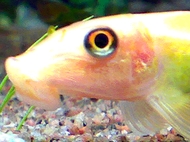Hjelp fiskedød!
Hei,
Har et 50l kar med en hann ancistrus sp. oppdrettsvariant og 2 mindre hunner som jeg ikke regner med er helt kjønnsmodne enda.
Dette karet er kun foreløpig, men det er innkjørt siden 1 år tilbake og har også 3 guppy yngler oppi her. PH er på ca 7,5. Kh og GH ca 2-3.
Er en god mengde sandsnegler her også og sand bunn. Av planter har jeg kun Javabregner festet til to røtter.
Inntil for en uke siden har alt gått helt fint da jeg begynte å røre og styre nedi bunnlaget og mye drit kom opp, dette var i kombinasjon med vannbytte og litt romstering nedi karet. Jeg burde aldri rørt sandbunnen for nå de siste dagene har alle mallene død og jeg har merket at min største ancistrus ikke har vært i slaget. nitritt, Amonniak viste ingen stygge verdier, men jeg har foretatt vannbytte ca 33% hver dag. I dag da jeg kom hjem fra arbeid var ancistrusen død og det såg ut som den hadde gått i oppløsning. Deler av halen begynte å falle av og finnen var begynt å løsne.
Utrolig Trist etter at jeg har hatt den i snart to år.
Det jeg lurer på er om noen vet av lignende erfaring at det å røre i bunnen kan orsake katastrofe. Jeg forstår at Masse gode bakterier lever der og døden kom etter jeg rørte rundt for å scape.
Har et 50l kar med en hann ancistrus sp. oppdrettsvariant og 2 mindre hunner som jeg ikke regner med er helt kjønnsmodne enda.
Dette karet er kun foreløpig, men det er innkjørt siden 1 år tilbake og har også 3 guppy yngler oppi her. PH er på ca 7,5. Kh og GH ca 2-3.
Er en god mengde sandsnegler her også og sand bunn. Av planter har jeg kun Javabregner festet til to røtter.
Inntil for en uke siden har alt gått helt fint da jeg begynte å røre og styre nedi bunnlaget og mye drit kom opp, dette var i kombinasjon med vannbytte og litt romstering nedi karet. Jeg burde aldri rørt sandbunnen for nå de siste dagene har alle mallene død og jeg har merket at min største ancistrus ikke har vært i slaget. nitritt, Amonniak viste ingen stygge verdier, men jeg har foretatt vannbytte ca 33% hver dag. I dag da jeg kom hjem fra arbeid var ancistrusen død og det såg ut som den hadde gått i oppløsning. Deler av halen begynte å falle av og finnen var begynt å løsne.
Utrolig Trist etter at jeg har hatt den i snart to år.
Det jeg lurer på er om noen vet av lignende erfaring at det å røre i bunnen kan orsake katastrofe. Jeg forstår at Masse gode bakterier lever der og døden kom etter jeg rørte rundt for å scape.
Postet 13.11.19 kl 00:52
I sand kan det danne seg giftige stoffer, utifra jeg har lest er det ikke veldig vanlig med fiskedød pga. disse gassene. Du har sandsnegler, noe som i utgangspunktet skal hjelpe mot at disse gassene dannes.
Fant en forum post på nettet som forklarer veldig godt hva disse gassene er:
Fant en forum post på nettet som forklarer veldig godt hva disse gassene er:
"The main concern people have about sand would be anaerobic bacteria build-up. Anaerobic meaning without air, though more accurately, without oxygen. If you didn't know, the ammonia and nitrite reducing bacteria require oxygen to work (to convert ammonia to nitrite and to convert nitrite to nitrate).
Anywho, under anaerobic conditions, bacteria start to get their energy from other sources, like reducing sulfur instead of oxygen. And a by-product of that is hydrogen sulfide, yes, one of the deadliest compounds in nature.
But, there is relief. In water, as soon as hydrogen sulfide comes into contact with any oxygen, it will become harmless. So, even if there is a pocket, and even if you accidentally stir it up, it will become harmless as soon as it hits your well-oxygenated water. And you know your water is well-oxygenated since your fish are living in it, and they need oxygen. This is the stinky smell you got, sulfurs, but you most likely smelled sulfur oxides, not hydrogen sulfide. Like I said, hydrogen sulfide decomposes very quickly in the presence of oxygen while in aqueous solution.
So, there really isn't anything down there to worry about, so my recommendation is to not stir it at all. Just vacuum the top of the sand to get the uneaten food off the top. If uneaten food on the top is a constant problem, you probably should be feeding less, maybe a lot less. If it really bothers you, maybe decrease the thickness of your sand layer.
p.s. Another source of energy anaerobic bacteria may use is actually to convert nitrates to nitrogen gas. This is what living rock and living sand does for some marine tank setups.
Here is another quote from another post of mine:
Diana Walstad in her book Ecology of the Planted Aquarium actually talks about the beneficial aspects of having anaerobic conditions under the substrate near the plant roots. She has around several inches of soil as the substrates in her tanks. The anaerobic bacteria will use most anything for an energy source, reducing nitrates is just one of them. The bacteria can also reduce iron, sulfur, manganese, and so on. The great thing for plants is that these reduced forms are much more easily taken up, so anaerobic conditions help the plants get their micronutrients."
Postet 13.11.19 kl 10:54
Endret: 13.11.19 kl 10:55



